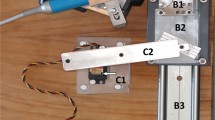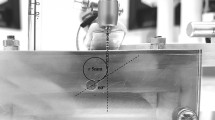Abstract
Endodontic rotary files are cutting instruments used to perform root canal procedures within a tooth interior. Focusing on quantitative fractographic analysis increases necessary, clinical performance understanding of file separation failure. This research employed controlled, dynamic testing to failure of commercial rotary files, analyzing the fractographic, forensic characteristics in relation to Weibull reliability determination, considering: (1) design analysis; (2) stress concentrations; (3) times to failure; (4) number of cycles to failure (NCF). Ex vivo testing included three file designs, each having constant tip size (0.035 mm), taper (0.06 mm/mm), and length (25 mm). Files were individually tested using an electric, torque-controlled handpiece, rotating within a standardized, simulated canal until fracture separation occurred. Fractographic analysis, including critical measurements, was conducted using the scanning electron microscope (SEM) (PhenomProX, PhenomWorld, NL). Weibull statistical analysis established reliability factors per design group. Fractographic analysis identified separation fractures, processing inclusions, flexural-fatigue striations, and stress concentrations at flute pitches. Calculated NCF median values (1277—EE; 899—VB; 713—PI) demonstrated significant statistical differences among groups (p < 0.001). Separated apical fragments yielded statistically significant differences (p ≤ 0.05) for varying file design groups. Weibull moduli among groups were statistically equivalent. Fractographic analysis exposed a presence of multiple failure factors in addition to defect distribution, governing cyclic fatigue failure originating at stress concentration points irrespective of file design. Fractographic analysis indicated that a change in file design, specifically at the working edges, in addition to improved surface finish, has the potential of reducing failures by lowering points of stress concentration and reducing fracture initiating surface cracks.







Similar content being viewed by others
References
Civjan S, Huget EF, DeSimon LB. Potential applications of certain nickel-titanium (nitinol) alloys. J Dent Res. 1975;54:89–96.
Walia HM, Brantley WA, Gerstein H. An initial investigation of the bending and torsional properties of Nitinol root canal files. J Endod. 1988;14:346–51.
Zinelis S, Eliades T, Eliades G. A metallurgical characterization of ten endodontic Ni-Ti instruments: assessing the clinical relevance of shape memory and superelastic properties of Ni-Ti endodontic instruments. Int Endod J. 2010;43:125–34.
Celik D, Tasdemir T, Er K. Comparative study of 6 rotary nickel-titanium systems and hand instrumentation for root canal preparation in severely curved root canals of extracted teeth. J Endod. 2013;39:278–82.
Pedir SS, Mahran AH, Beshr K, Baroudi K. Evaluation of the factors and treatment options of separated endodontic files among dentists and undergraduate students in riyadh area. J Clin Diagn Res. 2016;10:ZC18–23.
Plotino G, Grande NM, Cordaro M, Testarelli L, Gambarini G. A review of cyclic fatigue testing of nickel-titanium rotary instruments. J Endod. 2009;35:1469–76.
Shen Y, Cheung GS, Peng B, Haapasalo M. Defects in nickel-titanium instruments after clinical use. Part 2: fractographic analysis of fractured surface in a cohort study. J Endod. 2009;35:133–6.
Peng B, Shen Y, Cheung GS, Xia TJ. Defects in ProTaper S1 instruments after clinical use: longitudinal examination. Int Endod J. 2005;38:550–7.
Gao Y, Shotton V, Wilkinson K, Phillips G, Johnson WB. Effects of raw material and rotational speed on the cyclic fatigue of ProFile Vortex rotary instruments. J Endod. 2010;36:1205–9.
Johnson E, Lloyd A, Kuttler S, Namerow K. Comparison between a novel nickel-titanium alloy and 508 nitinol on the cyclic fatigue life of ProFile 25/.04 rotary instruments. J Endod. 2008;34:1406–9.
Al-Hadlaq SM, Aljarbou FA, AlThumairy RI. Evaluation of cyclic flexural fatigue of M-wire nickel-titanium rotary instruments. J Endod. 2010;36:305–7.
Larsen CM, Watanabe I, Glickman GN, He J. Cyclic fatigue analysis of a new generation of nickel titanium rotary instruments. J Endod. 2009;35:401–3.
Quinn G. Fractography of ceramics and glasses. NIST Special Publication, National Institute of Standards and Technology, Gaithersburg, MD, 2016. p. 960–16e2.
Mecholsky J, Powell S. Fractography of ceramic and metal failures. West Conshohoken, PA: ASTM Internatioal; 1984.
Mecholsky J. Quantitative fractography: an assessment. In: Fractography of glasses and ceramic. The American Ceramic Society, Westerville OH, 1991. p. 413–51.
Pruett JP, Clement DJ, Carnes DL Jr. Cyclic fatigue testing of nickel-titanium endodontic instruments. J Endod. 1997;23:77–85.
Freiman S, Mecholsky J. The fracture of brittle materials: testing and analysis. John Wiley & Sons, Hoboken, NJ, 2012.
Robertson SW, Ritchie RO. In vitro fatigue-crack growth and fracture toughness behavior of thin-walled superelastic Nitinol tube for endovascular stents: a basis for defining the effect of crack-like defects. Biomaterials. 2007;28:700–9.
Robertson SW, Ritchie RO. A fracture-mechanics-based approach to fracture control in biomedical devices manufactured from superelastic Nitinol tube. J Biomed Mater Res B Appl Biomater. 2008;84:26–33.
Newman J, Raju I. An empirical stress-intensity factor equation for the surface crack. Eng Fract Mech. 1981;15:185–92.
Taylor J. An introduction to error analysis. 2nd ed. Sausalito, California: University Science Books; 1997.
Tang WR, Smales RJ, Chen HF, Guo XY, Si HY, Gao LM, et al. Prevention and management of fractured instruments in endodontic treatment. World J Surg Proced. 2015;5(1):82–98.
Gao Y, Gutmann JL, Wilkinson K, Maxwell R, Ammon D. Evaluation of the impact of raw materials on the fatigue and mechanical properties of ProFile Vortex rotary instruments. J Endod. 2012;38:398–401.
Santos Lde A, Bahia MG, de Las Casas EB, Buono VT. Comparison of the mechanical behavior between controlled memory and superelastic nickel-titanium files via finite element analysis. J Endod. 2013;39:1444–7.
Acknowledgements
The authors appreciate the intellectual contributions and participation of Dr. N.J. Ruzycki, Director of Undergraduate Laboratories and the MSE Student Lab for SEM instrumentation consultation (Materials Science & Engineering, College of Engineering, UF). Authors thank Endoscopy Replacement Parts, Inc. (FL 32669) for fabrication of the precision testing block.
Author information
Authors and Affiliations
Corresponding author
Ethics declarations
Conflict of Interest
The authors declare that they have no conflict of interest.
Additional information
Publisher’s note Springer Nature remains neutral with regard to jurisdictional claims in published maps and institutional affiliations.
Rights and permissions
About this article
Cite this article
Mecholsky, J.J., Barrett, A.A., Jones, C.T. et al. Fractographic analysis of separated endodontic file designs. J Mater Sci: Mater Med 31, 104 (2020). https://doi.org/10.1007/s10856-020-06432-3
Received:
Accepted:
Published:
DOI: https://doi.org/10.1007/s10856-020-06432-3




